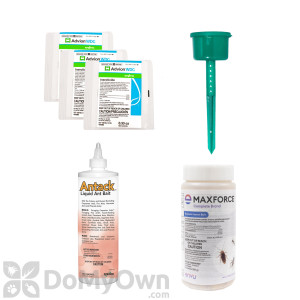What Do Argentine Ants Look Like
By DoMyOwn staff
Physical Appearance
- The most common type of Argentine Ant you will see is the wingless worker ant, which is 1/12 to 1/8 inch long
- Light to dark brown in color
- Single node in the waist
- Antennae has 12 segments
- The Argentine queen ant is 1/6 to ¼ inch long
- Tend to travel in trails
Argentine Ant control products
Behavior
The size of an Argentine Ant colony may number from one dozen to many thousands, with one or hundreds of queens. There is typically a large increase in argentine ant colony size in midsummer and early autumn. During the summer, several highly mobile satellite nests are established close to food sources. Unlike other pests, Argentine ants do not actually nest indoors, but establish their nests outside and enter homes and buildings in heavy trails in search of food-sources.
Feeding Habits
Argentine ants will invade homes in search of food and stop at nothing to get what they desire. Preferred cuisine of the Argentine ant includes other household pests (such as cockroaches and termites), aphids, plants, and sweet foods such as syrups, and honeydew.
Life Cycle
Argentine Ants lay elliptical, pearly-white colored eggs in the summer. Larvae will emerge within 28 days after the eggs are laid. The larval stage may then last anywhere from 11 to 60 days, followed by a pupal stage of 10 to 25 days. Thus, the entire life cycle of an Argentine Ant from egg to adult takes 2 to 3 months on average.
Damage
The Argentine Ant has been known to go to great lengths to get to a food source, such as enter refrigerators, and follow the spiral inside screw-top jars to taste its sweet contents. Argentine ants may also enter beds at night, seeking moisture provided by human bodies. They rarely bite, but when they get inside your home they can be a nuisance to live with and difficult to control.
Prevention & Control
- Wait, don't spray! With Argentine ants and most ant species, the use of dusts or residual sprays will only cause stress to the colony, causing it to split into a larger number of sub-colonies. This will actually worsen the infestation.
- Better to Bait- Baiting is preferred and a far more effective method of control than spraying or dusting. Try a slow-acting bait labeled specifically for Argentine Ant control:
View all Ant Control products
For more detailed information on Argentine Ant prevention and control, see How To Get Rid of Argentine Ants.
Other Related Articles:
Argentine Ant Colonies
Advantages of Ant Baits
Ant Baiting Tips
General Ant Control
12 of 14 people found this article informative and helpful.


